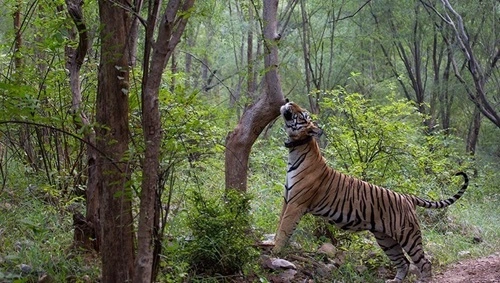Sariska, a renowned tiger reserve and wildlife sanctuary in Rajasthan, offers a unique blend of natural beauty, historical significance, and rich wildlife. Nestled in the Aravalli hills, the Sariska Tiger Reserve spans over 800 square kilometers and is home to a variety of wildlife species, including tigers, leopards, hyenas, sambars, and a wide range of bird species. Known for its beautiful landscapes and lush greenery, Sariska attracts wildlife enthusiasts, photographers, and nature lovers from across the country.
Choosing the best time to visit Sariska ensures that you experience the sanctuary’s vibrant ecosystem while making the most of wildlife sightings and scenic beauty. From the cool winters to the dramatic monsoon landscapes, each season in Sariska has something unique to offer. Here’s a guide to help you plan your trip to this captivating sanctuary.

The Allure of Sariska Tiger Reserve
Sariska is not only a paradise for wildlife lovers but also a place of cultural and historical significance. The reserve houses the ancient Kankwari Fort, which offers panoramic views of the jungle, and the 10th-century Neelkanth Mahadev Temple complex, showcasing the architectural grandeur of ancient Rajasthan. Additionally, Sariska’s proximity to the Alwar district makes it easily accessible, allowing visitors to explore nearby attractions like the Bala Qila (Alwar Fort) and the stunning Siliserh Lake.
The sanctuary’s terrain, characterized by rocky hills, dry deciduous forests, and seasonal water bodies, makes it an ideal habitat for diverse flora and fauna. While the Bengal tiger is undoubtedly the star attraction, Sariska is also home to leopards, jackals, wild boars, and numerous deer species. Bird watchers can spot various avian species, including peafowls, partridges, and endangered Egyptian vultures.
Best Seasons to Visit Sariska
1. Winter (October to March)
Winter is the best season to visit Sariska, as the weather is cool and pleasant, with temperatures ranging from 8°C to 22°C. The refreshing climate makes it comfortable for safaris and exploring the reserve’s landscapes. This season also offers excellent visibility, enhancing wildlife sightings as animals are more active during the day.
The early mornings and late afternoons in winter are ideal for spotting wildlife, particularly around water bodies where animals gather to drink. The open jeep safaris are enjoyable in this season, allowing visitors to experience the thrill of spotting tigers and other wildlife amidst the crisp winter air. The chances of sighting the elusive tiger increase during this period, as the animals are more likely to be out in search of food.
Winter is also the season for birdwatchers, as migratory birds flock to Sariska from colder regions. The sanctuary’s trees and water bodies come alive with various species, including storks, flamingos, and waterfowl. The Kankwari Fort and Neelkanth Temple, located within the reserve, are best explored during winter, as the cool weather allows for a comfortable visit to these historical sites.
If you plan to visit in winter, it’s advisable to book safaris in advance, as this is the peak season, and demand can be high. Early morning and late afternoon safaris are highly recommended for the best wildlife sightings.
2. Summer (April to June)
Summer in Sariska can be intense, with temperatures soaring above 40°C, especially in May and June. However, summer is also a great time for wildlife enthusiasts, as the scarcity of water drives animals to congregate around the few remaining waterholes. This makes it easier for visitors to spot tigers, leopards, and other animals seeking relief from the heat.
Though the heat can be challenging, early morning and evening safaris allow visitors to witness incredible wildlife activity, as animals tend to be more active during these cooler parts of the day. For photographers, the summer season offers opportunities to capture the raw beauty of the sanctuary’s rugged terrain and its inhabitants, as the dry season enhances visibility in the forest.
If you choose to visit Sariska in summer, take precautions to stay hydrated and wear light, breathable clothing. Safari guides and drivers are well-prepared for summer safaris, and they know the best spots for animal sightings during the heat. Many serious wildlife photographers and enthusiasts visit during this time, as it’s one of the best seasons for spotting big cats and other elusive species.
3. Monsoon (July to September)
The monsoon season brings a fresh transformation to Sariska, with moderate to heavy rains turning the dry landscapes into a lush, green paradise. Temperatures range from 25°C to 35°C, and the air is filled with the earthy fragrance of rain-soaked soil. While the sanctuary officially remains open during the monsoon, safaris may be limited, as certain areas become inaccessible due to slippery and muddy trails.
The monsoon season is ideal for nature lovers who appreciate scenic beauty and the freshness that the rains bring. The foliage is thick, making it challenging to spot wildlife, but the atmosphere is peaceful and vibrant. Peacocks and other birds are often seen displaying their feathers after the rain, adding to the visual charm.
The monsoon season also sees fewer tourists, so those who prefer a quieter experience will enjoy the tranquility of Sariska during this time. However, it’s essential to check with the sanctuary authorities in advance, as safari availability may vary. Carry rain gear, and be prepared for the possibility of limited wildlife sightings due to the dense vegetation.
Key Attractions and Activities in Sariska
- Jeep Safari: A jeep safari is the best way to explore the reserve and get up close to its wildlife. Experienced guides lead the safari, taking visitors to prime spots for wildlife sightings. The early morning and evening slots offer the highest chances of spotting tigers and leopards.
- Kankwari Fort: Located within the reserve, Kankwari Fort offers breathtaking views of the surrounding jungle. It is believed that Mughal Emperor Aurangzeb imprisoned his brother Dara Shikoh here, adding a historical layer to the fort’s allure.
- Neelkanth Mahadev Temple: This ancient temple complex, dating back to the 10th century, is located deep within the reserve. Dedicated to Lord Shiva, the temple complex showcases intricate carvings and sculptures, offering a fascinating blend of history and spirituality.
- Birdwatching: Sariska is a paradise for bird enthusiasts, especially in winter when migratory birds arrive. Visitors can spot species like peacocks, partridges, sandgrouse, and various birds of prey. The sanctuary’s diverse avian population adds color and life to its landscapes.
- Siliserh Lake: Located near Sariska, Siliserh Lake is a beautiful spot for a day trip. The lake offers boating facilities, and the Siliserh Lake Palace nearby has been converted into a hotel, allowing visitors to relax and enjoy the scenic surroundings.
Practical Tips for Visiting Sariska
- Safari Timings: The reserve typically offers two safari slots, one in the early morning and another in the late afternoon. Booking safaris in advance, especially during peak seasons, is highly recommended to secure a spot.
- Clothing and Essentials: Dress according to the season. Light, breathable clothing is suitable for summer, while warm layers are necessary for winter mornings and evenings. In monsoon, carry rain gear and wear sturdy footwear for walking around the fort and temple areas.
- Permits and Entry: The Sariska Tiger Reserve requires an entry permit, which can be obtained on-site or through online bookings. It’s advisable to confirm entry requirements before your visit.
- Photography: Sariska is a fantastic place for wildlife and landscape photography. Carry a camera with a good zoom lens to capture animals from a distance, and avoid using flash as it may disturb the wildlife.
- Respecting Wildlife: Visitors are encouraged to follow the sanctuary’s guidelines and respect the natural habitat. Avoid making loud noises, do not litter, and follow the instructions of safari guides.
Conclusion
Sariska is a sanctuary that offers more than just wildlife sightings—it provides an opportunity to connect with nature, explore Rajasthan’s rich heritage, and experience the thrill of spotting tigers in their natural habitat. From the cool and vibrant winters to the serene beauty of the monsoon, each season at Sariska brings its own unique charm. Whether you’re a wildlife enthusiast, a history buff, or a nature lover, planning your visit to Sariska according to your preferences will make your journey even more memorable. This reserve is a testament to India’s dedication to wildlife conservation and a must-visit destination for anyone seeking an authentic wilderness experience in Rajasthan.


